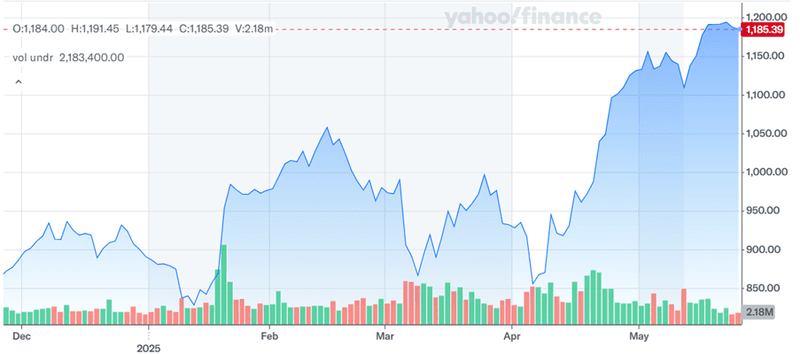Netflix Just Hit A New Gear — But Is The Stock Still Worth Streaming?

Netflix (NASDAQ:NFLX) is navigating a dynamic phase marked by explosive growth, innovative expansion, and intensifying external challenges. While the company recently edged toward a $500 billion market cap and reported robust revenue and subscriber numbers, it is also facing new economic and political headwinds that could alter its trajectory. With the launch of its proprietary ad-tech platform, deeper integration of AI tools, global content commitments, and a growing portfolio of live events—including exclusive NFL games—Netflix is expanding its footprint far beyond on-demand streaming. At the same time, looming threats like potential 100% tariffs on foreign-produced films and valuation concerns are complicating its outlook. Investors are left to consider whether these aggressive moves represent the next evolution of entertainment or introduce risks that could cap Netflix’s stellar run.
Live Events: A Double-Edged Engagement Sword
Netflix’s foray into live programming has quickly become a cornerstone of its engagement strategy. With events like the NFL Christmas games and the Paul-Tyson fight setting streaming records, the platform has demonstrated its ability to attract real-time viewers and generate buzz. These events serve multiple strategic purposes: they increase user engagement, provide compelling advertising inventory, and improve subscriber retention. The recent announcement that Netflix will host two more NFL games on Christmas Day 2025 highlights its commitment to live content. Moreover, these high-visibility broadcasts can attract new demographics and even bring back lapsed users. On the downside, live content demands a fundamentally different infrastructure and incurs higher production and licensing costs. The company must also compete with established networks and tech giants with long-standing sports partnerships. Another concern is the return on investment for such high-cost events, especially when measuring retention beyond the immediate spike in viewership. Additionally, while Netflix emphasizes only pursuing live opportunities that make economic sense, the competitive bidding environment for sports rights may pressure margins. With live events still representing a small fraction of total viewing hours, the scalability of this content type remains a question. Nevertheless, Netflix’s global ambitions include expanding these events beyond the U.S., indicating further capex and risk. Ultimately, live events offer upside in terms of branding and ad revenue but require disciplined execution to avoid becoming a cost center.
Tariff Risks: A Potential Blow To Global Content Economics
Netflix’s long-standing immunity to global trade tensions may be fading. President Donald Trump’s proposal to impose a 100% tariff on foreign-produced films introduces a serious threat to the company’s international content strategy. Citi estimates that approximately 50% of Netflix’s content is produced outside the U.S., and the implementation of these tariffs could cut earnings per share by around $6. While Netflix is exploring mitigation strategies—such as shifting production to the U.S., geo-restricting foreign content, or raising prices—each of these responses comes with drawbacks. Relocating production could increase costs and strain existing creative partnerships. Raising prices might deter new subscribers or accelerate churn, especially in price-sensitive markets. Restricting content access for U.S. viewers could undermine Netflix’s global brand image and reduce content diversity. Furthermore, the uncertainty around the timing, scope, and enforcement of such tariffs complicates forward-looking guidance and capital allocation. Analysts like Raymond James’ Andrew Marok emphasize that much depends on exemptions and implementation details, but the risk to margins and subscriber satisfaction is clear. Historically, Netflix has thrived during macroeconomic instability, but this is the first time its global sourcing model is being directly challenged by U.S. policy. Investors must now reassess the company's once “tariff safe haven” status, and management has acknowledged that international risk is a constant concern, although no changes have yet been made to forecasts. Tariff developments could add unexpected volatility to Netflix’s future quarters.
AI Integration: A Catalyst For Efficiency Or A Budget Trap?
Netflix is increasingly integrating artificial intelligence into its production workflows, aiming to improve both the efficiency and quality of content creation. The company has cited examples like Rodrigo Prieto’s use of AI-powered tools in “Pedro Páramo” to replicate advanced VFX at a fraction of previous costs, such as those incurred during the making of “The Irishman.” These innovations promise to democratize access to high-quality production tools, enabling lower-budget projects to achieve premium aesthetics. Netflix executives argue that even a 10% improvement in creative output could be more valuable than a 50% cost reduction. Additionally, AI is being used in set design, pre-visualization, and visual effects, making it integral to the future of Netflix’s content strategy. However, the deployment of AI is still in early stages and comes with operational and reputational risks. Misuse or overreliance could dilute the creative process or generate backlash from the filmmaking community. The ethical considerations around AI-generated content, especially amid ongoing labor discussions in Hollywood, also pose reputational challenges. Moreover, the upfront investments in AI infrastructure and training may not yield immediate returns, especially if consumer expectations outpace technological capabilities. Still, the company remains confident that its data science and product innovation culture give it an edge over competitors in harnessing AI. Whether this translates to sustained margin expansion or simply an arms race in tech spending will become clearer over the next few years.
Gaming Expansion: Long-Term Vision Meets Near-Term Caution
Netflix continues to build out its gaming division, treating it as a long-term bet on deeper user engagement. With offerings ranging from narrative-driven experiences tied to existing IP (e.g., Squid Game: Unleashed) to licensed titles like Grand Theft Auto and children’s games like Peppa Pig, the company aims to develop a diverse portfolio. Its strategy revolves around ad-free, in-app purchase-free gaming—delivered as part of the subscription—to build loyalty and increase daily time spent on the platform. Netflix sees potential in socially engaging formats, such as party games or interactive game shows. However, executives admit the gaming journey is still in its infancy, with a modest budget and measured investment strategy. While early signals show increased retention among users who play games, the user base remains small, and the feature is underutilized relative to its potential. Discovery and user experience within the Netflix app are current pain points. Additionally, competing with established mobile and console game ecosystems, without dedicated hardware or a strong studio brand, poses an uphill battle. The company’s cautious approach—scaling investment only as confidence grows—minimizes downside risk, but it also means slower monetization. With a $140 billion global gaming market in view, Netflix’s success depends on achieving product-market fit and iteratively improving its catalog and interface. For now, gaming enhances Netflix’s “all-in-one” value proposition, but its material contribution to revenue remains aspirational.
Final Thoughts

Source: Yahoo Finance
Netflix’s explosive growth phase has clearly not been restricted to its financials as we see a massive appreciation in its stock price over the past 6 months, which was a rather tumultuous phase for U.S. markets as a whole. We see a marked improvement in investor perception as well, with Netflix’s LTM EV/ Revenue increasing from 8.09x in March 2024 to 12.78x today indicating the market’s strong expectations regarding Netflix’s future growth.
Today, we see Netflix as a company in transition—one that is evolving its business model beyond streaming to include live events, interactive gaming, and cutting-edge AI applications, while also confronting new external risks such as content tariffs. Each of these strategic moves offers potential upsides for engagement, monetization, and brand differentiation, yet they come with operational complexities and financial uncertainties. As Netflix approaches key inflection points in its margin profile, content strategy, and global market dynamics, it is important to weigh both, the growth opportunities and emerging risks, before making long-term investment decisions in the Netflix stock, especially at such high multiples.




